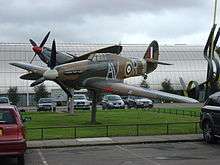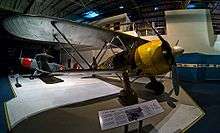Royal Air Force Museum London
 | |
| Established | 15 November 1972 |
|---|---|
| Location |
Colindale London, NW9 United Kingdom |
| Type | Aviation museum |
| Public transit access |
|
| Website |
www |
The Royal Air Force Museum London, commonly called the RAF Museum, is located on the former Hendon Aerodrome, with five major buildings and hangars dedicated to the history of aviation and the Royal Air Force. It is part of the Royal Air Force Museum, a non-departmental public body sponsored by the Ministry of Defence and a registered charity.[1]
A second collection of exhibits, plus aircraft restoration facilities, is housed at the Royal Air Force Museum Cosford at RAF Cosford in Shropshire, five miles northwest of Wolverhampton.
History
The museum was officially opened at the Colindale (then part of Hendon) London site on 15 November 1972 by Queen Elizabeth II. The hangars housed 36 aircraft at opening. Over the years, the collection increased, and aircraft not on display at Hendon were stored or displayed at smaller local RAF station museums.
The first Director of the Museum was Dr John Tanner who retired in 1987. In 1988, Dr Michael A. Fopp (who had previously directed the London Transport Museum) was appointed Director General of all three sites operated by the Museum. Retired Air Vice-Marshal Peter Dye replaced Fopp as Director General on 9 June 2010.[2] In October 2014, it was announced that Maggie Appleton was to be appointed as CEO of the museum.[3] Appleton took up the new role in January 2015, a departure from the traditional role of Director General which was held by Peter Dye until his retirement in late 2014.
Description

The Royal Air Force Museum London comprises five exhibition halls:
- Milestones of Flight
- The Bomber Hall
- Historic Hangars
- The Battle of Britain Hall
- The Grahame-White Factory
As of 2010, it had over 100 aircraft, including one of only two surviving Vickers Wellingtons left in the world and the Avro Lancaster S-Sugar, which flew 137 sorties. It also includes the only complete Hawker Typhoon and the only Boulton Paul Defiant in the world.
Recently added to the museum is a Consolidated B-24 Liberator, which was moved to Hendon from Cosford. It was presented to the museum by the Indian Air Force. In exchange, a Vickers Valiant was sent to Cosford to become part of the new Cold War exhibition. In 2009 the museum took delivery of a FE2b World War I bomber, which had been in production for the museum for over 18 years and is one of the few examples of this aircraft in the world.
There is a large car park at the site, and reasonable public transport links, with Colindale tube station around a 10-minute walk away.
In April 2009, work began on The Battle of Britain Hall to improve lighting conditions and provide full re-cladding to the exterior of the building. This new form of energy-saving lighting can change colour and light intensity while still being cheaper to run. It is kinder to the exhibits because it does not emanate UV light,and light intensity can be increased between each "Our Finest Hour" showing. The hall will also benefit from a new glass fascia overlooking the Sunderland flying boat making it viewable from outside and also providing natural daylight throughout the Sunderland Hall, a section within the Battle of Britain building. Works were completed in August 2009.
Aircraft on display
Milestones of Flight

- BAe Harrier GR.3
- Bleriot XI
- de Havilland DH.60 Moth
- de Havilland Mosquito B.35
- Eurofighter Typhoon (prototype)
- Fokker DVII
- Gloster F.9/40
- Hawker Hart II
- Hawker Tempest V
- Lockheed Martin F-35 Lightning II (display mockup)
- North American P-51D Mustang
- Percival Mew Gull
- Sikorsky R-4
- Sopwith Camel
- Messerschmitt Me 262A-2a Schwalbe
The Bomber Hall

- Airspeed Oxford I
- Avro Anson I
- Avro Lancaster B.I
- Avro Vulcan B.2
- Boeing B-17G Flying Fortress
- Consolidated B-24L Liberator
- Fairey Battle
- Focke Wulf Fw 190A-8/U-1
- Handley Page Halifax II (recovered wreck)
- Hawker Siddeley Buccaneer S.2B
- Heinkel He 162A-2
- North American TB-25J Mitchell
- Panavia Tornado GR.1A
- Percival Prentice
- Royal Aircraft Factory B.E.2B
- Royal Aircraft Factory F.E.2B
- Saunders-Roe Skeeter AOP.12
Historic Hangars
Battle of Britain Hall

- Bristol Blenheim IV
- de Havilland Tiger Moth
- CASA 1.131 Jungmann (Spanish Air Force - E-3B)
- Fiat CR.42 Falco
- Gloster Gladiator I
- Hawker Hurricane I
- Heinkel He 111H-20
- Junkers Ju 87G-2
- Junkers Ju 88R-1
- Messerschmitt Bf 109E-3
- Messerschmitt Bf 110G-2
- Short Sunderland MR.5
- Supermarine Seagull V
- Supermarine Spitfire I
- V1 Flying Bomb
- V-2 Rocket
- Westland Lysander III
The Grahame-White Factory

- Avro 504K
- Bleriot XXVII
- Bristol M.1c
- Caudron G.3
- Hanriot HD.1
- Royal Aircraft Factory S.E.5A
- Sopwith 1½ Strutter
- Sopwith Dolphin
- Sopwith Pup
- Sopwith Tabloid
- Sopwith Triplane
- Vickers F.B.5
- Vickers Vimy
Engines on display
See also
References
External links
| Wikimedia Commons has media related to RAF Museum London. |
- Official website
- RAF Museum Photo website
- Royal Air Force website
- Photo galleries of aircraft at the RAF Museum and a virtual tour of RAF Cosford
- Images taken at RAF Museum London
Coordinates: 51°35′56″N 0°14′19″W / 51.59889°N 0.23861°W